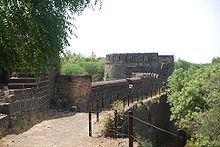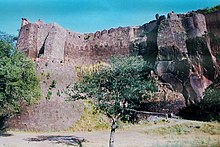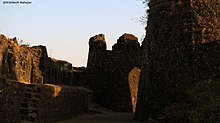Second marath war
The Second Marathas War was a military conflict between the British East India Company and the Marathon Empire from 1803 to 1805.
prehistory
The Peshwa Baji Rao II nominally presided over Maratha , a confederation of petty kings, the most powerful of which were the Gaekwad in Baroda ( Gujarat region ), the Scindia in Gwalior (south of Agra ), the Holkar in Indore ( Malwa region ) and the Bhonsle were in Nagpur ( Berar region ).
Feeling pressured by the Scindia, the Peshwa reluctantly sought a military alliance with the British East India Company for security. The Governor General of Fort William Richard Colley-Wellesley, 1st Marquess Wellesley , hoped this alliance would bring Maratha under British influence. The negotiations dragged on for months. Baji Rao II wanted to avoid the presence of British troops on his territory, fearing that he would become a British vassal. The question of costs also had to be clarified.
While the negotiations were still ongoing, the Holkar in Indore came to a controversial succession to the throne. Jeswant Rao Holkar had taken power in most of the Holkar area after fighting. Baji Rao II and Scindia sided with his opponents. Jeswant Rao suffered a number of defeats against Gwalior, but reorganized his army with the help of foreign military and defeated the combined armies of Peshwas and Scindias in the Battle of Pune on October 25, 1802 .
Now Baji Rao II accepted all British terms and signed the Bassein Treaty with them at the end of December . With that he lost his sovereignty in foreign affairs.
Meanwhile, Jeswant Rao had installed another pretender on the throne of Peshwas. The British now sent Major General Arthur Wellesley , the brother of the Governor General, with a force to Pune . Jeswant Rao withdrew without a fight and Baji Rao II was used again as Peshwa on May 13, 1803. Gaekwad also signed a contract with General Wellesley.
At the end of May Daulatrao Scindia von Gwalior had raised an army and was in alliance negotiations with Raja Raghoji II from Berar and Jeswant Rao Holkar from Indore to march on Pune. In July 1803 Arthur Wellesley asked Daulatrao to withdraw his army south and Raghoji II to go to his capital Nagpur.
When both of them failed to comply, war broke out in August 1803.
Course of war
The fighting took place in four different theaters of war: on the east coast of India in Orissa , where the British took the port of Puri des Raja of Berar , at Balasore , which was taken after a sea landing, and on the west coast, where Colonel Murray ran the Scindia- Fort Broach took and other areas of Gwalior in Gujarat occupied.
However, the main fighting took place in the Deccan . Wellesley had 11,000 infantrymen (including 1,600 Europeans) and 5,000 cavalrymen Mysores and the troops of the Peshwa. Another 9,000 men from Hyderabad and a Scottish regiment operated, mostly independently, under the command of Colonel Stevenson.
Wellesley's campaign
On August 11, 1803, Wellesley took the Ahmednagar Fortress, protecting Pune from attack. The enemy maneuvered for the next few weeks until Wellesley managed to keep them out of the Hyderabad area. On September 22, 1803, he split his force before a parade to reduce the risk. Colonel Stevenson was to take another route and join him before September 24th to attack the main Marathan army. But on September 23, after a long night march, Wellesley was reported to be nearby and preparing to leave. Wellesley decided to attack immediately and not wait for Stevenson, fearing the opponent might evade a fight. In the following Battle of Assaye he defeated a vastly outnumbered force and was able to take Burhanpur and the fortress of Asirgarh in the next few weeks . After these defeats, Scindia asked for a truce, which the British agreed to.
Wellesley now turned to Berar's troops, who were moving south and marching on Hyderabad. He managed to catch up with them in quick marches and defeat them on November 29, 1803 at the Battle of Argaon . Some of the surviving Marathas fled to Gawilgarh fortress . On December 15, 1803, the fortress was stormed with minor losses, and Raja Raghoji II of Berar asked for peace.
Lakes campaign
General Gerald Lakes' task was to fight the forces of Scindia in its areas of Hindustan, which were under French influence . At the end of August 1803 he invaded the area of Gwalior with six cavalry regiments and twelve infantry battalions and on September 4, 1803 stormed the fortress of Aligarh . He now advanced further and defeated Daulatrao Scindia's army on September 11 at the Battle of Delhi . On September 16, he entered Lake Delhi and paid his respects to Mughal Mughal Shah Alam II . The Mughal Empire had long since perished, but the Great Mughal still had a great reputation.
Next turned to Lake Agra , which he captured on October 18th. In the meantime Daulatrao Scindia had sent an army of 17 infantry battalions and 4-5,000 cavalrymen north. On November 1st, the Battle of Laswari broke out , and Lake won another great victory. After that there was only minor fighting.
At the end of December the British made peace with Daulatrao Scindia and Rhagoji II.
War with Holkar
Jeswant Rao Holkar, the ruler of Indore, viewed the increase in power of the British with suspicion and did not want to give up his raids into neighboring countries. In March 1804 he unsuccessfully sought an alliance with Scindia and smaller rulers in order to fight together against the British. This was not hidden from them, and so Governor General Wellesley decided in April that war was inevitable.
General Lake began the campaign against Holkar in late April, but soon had to stop it and decided to wait for the rainy season to end, as the Indian summer made fighting nearly impossible. He posted Colonel Monson with five and a half battalions and some irregular cavalry to hold the passes north of Kotah and thus prevent Holkar's return to Hindustan.
But Monson left this post and advanced south into the area of Holkar. An attempt to unite with Colonel Murray's forces failed and Monson was forced to withdraw under constant attack.
While the venture was not a serious setback, it resulted in a loss of British reputation that resulted in the Rajas of Bharatpur changing sides .
Jeswant Rao advanced far into Hindustan, occupied Muttra and attacked Delhi in October. The defenders, Ochterlony and Burn, held out, however, until Jeswant Rao withdrew as Lake's army approached. Jeswant Rao sent his infantry to Dig Fort while he was going on a raid with the cavalry.
Lake sent Major General Frazer to Dig with most of the infantry, artillery and two regiments of cavalry, while he himself took up the pursuit of Jeswant Rao with six regiments of cavalry, little infantry and some artillery. On the night of November 16, 1804, he succeeded in confronting the enemy and defeating him at the Battle of Farrukhabad . Meanwhile, Frazer had won the Battle of Dig , but was killed in the process. Monson took command and, despite the success, withdrew to Agra instead of besieging Dig. Lake now marched from Farrukhabad to Dig and stormed the fortress on Christmas Eve. The remains of Jeswant Rao's infantry held the fortress of Bharatpur .
Lake went to Bharatpur with his troops. Since the fortress could not be defeated with the available light artillery and the moat was deep, Lake would have had to wait several weeks for siege artillery and other material. Not willing to accept this loss of time, he decided to attempt an assault on January 9, 1805, which was repulsed with heavy losses. Over the next six weeks he made three more attacks, which also failed. After losing 3,000 soldiers, Lake withdrew and awaited the arrival of heavy artillery. At this point the Raja of Bharatpur decided to sign a peace treaty. The supply train with the heavy artillery was attacked by mercenaries of Holkar under Amir Khan's command, but they were defeated after a long pursuit. It was April now and the fighting ceased due to the hot season.
Governor General Wellesley's administration and expansion policy brought him into opposition to the Court of Directors , the decision-making body of the East India Company, which found it wrong and too costly, and so he was recalled in May 1805. His successor as Governor General, Charles Cornwallis , wanted to end the war quickly, but died just two months after taking office; however, the acting successor George Barlow pursued his policy further.
Jeswant Rao Holkar, who had only a few thousand cavalry left and no longer believed in the support of Scindia, moved in September 1805, pursued by Lake, through Rajputana to the Punjab , where he hoped for an alliance with the Sikh leader Ranjit Singh . Hope was not fulfilled, and so he made an advantageous peace with the British while still in Punjab.
Consequences and effects of the war
Berar ceded his province of Cuttack to the British, all areas west of the Wardha to the Nizam Mir Akbar Ali Khan Asaf Jah III. from Hyderabad. Daulatrao Scindia lost broach and possessions in Gujarat, ceded all territories south of the Ajana Mountains to the Nizam and Peshwa in the Deccan , and lost Agra, Delhi and other possessions to the British in the north. Schindias / Gwalior's independence had to be accepted by the Peshwa.
In the future, both states had to accept the mediation of the British in the event of disagreements with one another and with the Nizam. In addition, they were not allowed to recruit European soldiers without British approval. Holkar had gotten off scot-free thanks to the change in British political leadership and their desire to make peace absolutely. The British had become the undisputed supremacy in India, consolidated their power and pushed back French influence.
General Lake was made a baron for his services , and Wellesley was accepted into the Order of the Bath .
literature
- Randolf GS Cooper: The Anglo-Maratha Campaigns and the Contest for India: The Struggle for Control of the South Asian Military Economy . Cambridge University Press, Cambridge and New York 2003, ISBN 978-0521824446
- MS Naravene: Battles of the Honorable East India Company . Chaman Enterprises, New Delhi 2006.
- Edward Penderel Moon : The British Conquest and Dominion of India , Duckworth Publ., London 1990. ISBN 0-7156-2169-6
- Jac Weller: Wellington in India , Greenhill Books, London 1993. ISBN 1-85367-397-8
Individual evidence
- ↑ Sir Penderel Moon: The British Conquest and Dominion of India , Duckworth Publ., London 1990. p. 320.







